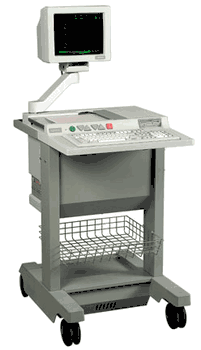Need Immediate Help? Call Toll Free 800.866.6689
Quinton stress test systems feature our internationally-acclaimed algorithm that is used by thousands worldwide. This algorithm has a proven record for reliability and accuracy in demanding clinical situations; and it's just one of several reasons why Quinton is a recognized market leader in the stress testing equipment business.
Design Your Display Format
The Q4500 gives you more flexibility in determining the appearance of the display during the stress test. Select from eight standard audio and/or visual alarms and pre-set them based on your patient's particular threshold levels.
Show a heart rate pie graph within the header. Touch a key to display one of nine other graphs on screen, including worst-case ST graphics, ST trends, and more. The Q4500 will continue to display all three leads.
Present resting and/or current averages alongside live ECG signals--even show them on the left or right side of the screen (the ECG waveforms shift to accommodate your preference).
Filters for Cleaner Traces
The Q4500 uses digital filters (patent pending) that dramatically reduce muscle artifact and baseline wander on your live ECG tracings.
The muscle artifact filter minimizes the artifact you see, with virtually no distortion of the ECG signal. In effect, this powerful digital filter adjusts its strength to cut away as much artifact as necessary, while carefully avoiding over-filtering which can cause signal distortion.
The Q4500 also uses a filter with a powerful linear phase response to suppress baseline wander. All while preserving the fidelity of the ECG signal and providing accurate ST measurements. The result is crisp, clear signals and traces.
Customize Your In-test Reports
The Q4500 lets you design your in-test reports in a variety of ways. Include and arrange any combination of data within two different report headers. Move these header blocks to the top or bottom of the page. Then ask yourself some questions.
Do I want 12-lead reports with or without a rhythm strip? In a 6 x 2, 3 x 4, or other column size? Should I format that with or without current resting, and worst case averages? Where do I want the averages: to the left or right of the ECG waveforms?
You get the basic idea. The Q4500 allows you to easily customize your reports in an almost unlimited number of combination's. That means more freedom to design your reports in the way you (and medical records) prefer.
Pre-Edit during Your Patient's Recovery
Now you can preview the final report and enter final report information while your patients are still in the recovery phase. That means you can start entering data immediately rather than waiting until the end of recovery to enter final report information. Enter your reason for ending the test, test impressions, and test conclusions. During this time the Q4500 continuously displays ECG waveforms in case any significant changes occur during your patient's recovery.
Customize Your Final Reports
Like many other systems, the Q4500 lets you include a summary page, interpretation, tabular report, graph page, average beat, and worst case summary for your final reports. But with the Q4500, you can also create your own personal formats. Select from over 30 different data templates; arrange them anywhere within the summary and interpretation headers.
For the graph section, select up to nine graph types, including a full ST/HR slope graph, HR x BP, systolic and diastolic BP, and more. And choose from a variety of average beat reports with different channels and leads.
Best of all, you can name, store and review up to three of your own final report formats internally, or store an almost unlimited number of diskette. Use them again and again, or make variations at any time.
Includes: Stress System, Q55 or Q65 Treadmill, Patient Cable w/ Leads and Treadmill Interface Cable. Accessories: Stress electrodes, paper, instruction manual, and power cords.

